Disclaimer: Our content doesn't constitute medical or fitness advice. We may be earning money from companies & products we review. Learn more
The kettlebell snatch is a dynamic full-body movement that requires skill, strength, and coordination. It’s an absolute cornerstone of kettlebell training for most of my personal training clients, offering loads of benefits while posing challenges that demand dedication and technique refinement.
It’s what I call a “lifetime” movement: you can work on your snatch for a lifetime and still find ways to make it better. It’s an absolute bulldozer of a movement that gets your heart rate up, burns fat, gets your grip strength in tip-top shape, and, most of all, it can produce unreal strength gains.
The kettlebell snatch is a great singular movement to throw into any set as a finisher or to make your existing workout much more intense. Here’s how to do it the right way.
Table of Contents
- 1 How to Perform the Kettlebell Snatch
- 2 Useful Tips for Perfecting the Kettlebell Snatch
- 3 Kettlebell Drills (The 3 Components of the Snatch)
- 4 Why Do the Kettlebell Snatch?
- 5 Muscle Groups Targeted by the Kettlebell Snatch
- 6 Challenges to Watch Out For
- 7 Sample Workout & Progression
- 8 The Snatch: The King of Kettlebell Movements
How to Perform the Kettlebell Snatch
1. Starting Position:
Begin by standing with your feet hip-width apart, and place a kettlebell on the ground in front of your feet.
Hinge at your hips and slightly bend your knees to reach down and grasp the kettlebell with one hand. Your back should be flat, and your chest should be up. Shoulders should not be below hips.
2. Hip Hinge:
Initiate the movement by driving your hips back, keeping your back straight, and maintaining a neutral spine.
The movement should be similar to the hip hinge in a kettlebell swing or kettlebell deadlift.
3. Explosive Extension:
As you hinge forward, extend your hips explosively, driving them forward.
Simultaneously, pull the kettlebell towards your body using your hips, while keeping your arm straight.
4. High Pull:
Once the kettlebell reaches chest height, transition from the swing to a high pull by bending your elbow and bringing the kettlebell toward your shoulder.
5. Punch Through:
As the kettlebell reaches its peak and becomes weightless, punch your hand through the handle, allowing the kettlebell to flip over and rest on the back of your wrist. It should not hurt you.
If it does, you either punched too soon or too late. Pay attention to the “weightless feeling” as that’s the perfect time to “punch”.
6. Lockout:
In the overhead position, your arm should be fully extended, and your wrist, elbow, and shoulder should be in a straight line.
Tighten your core and engage your shoulder and back muscles to stabilize the weight overhead.
7. Lowering the Kettlebell:
To bring the kettlebell back down, you’ll have two options:
- Rack the kettlebell at your chest then lower it down
- Push through and reverse the motion by bending your elbow, bringing the kettlebell back to the high pull position.
Allow the kettlebell to descend between your legs, and then hinge at the hips to return it to the starting position.
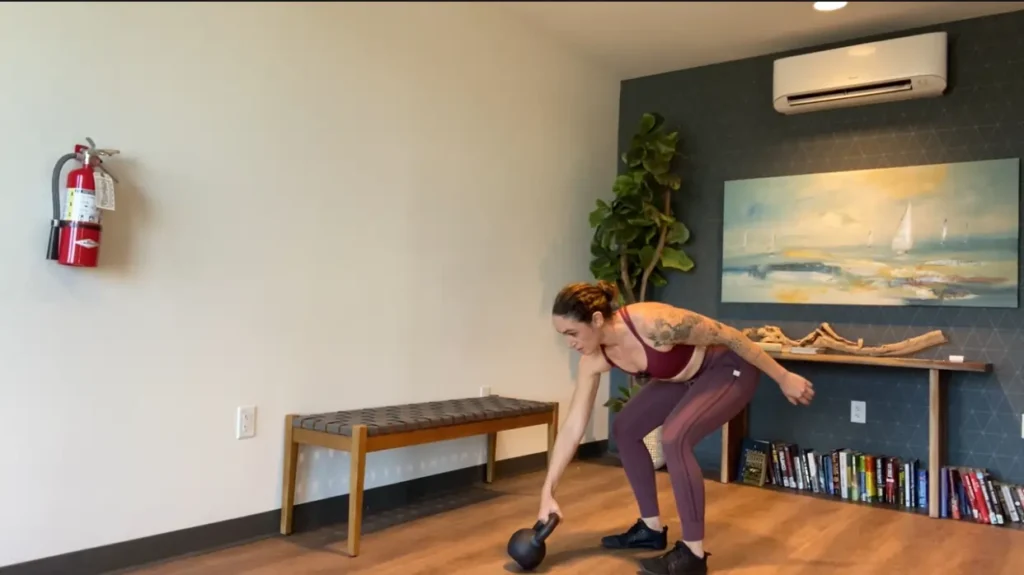
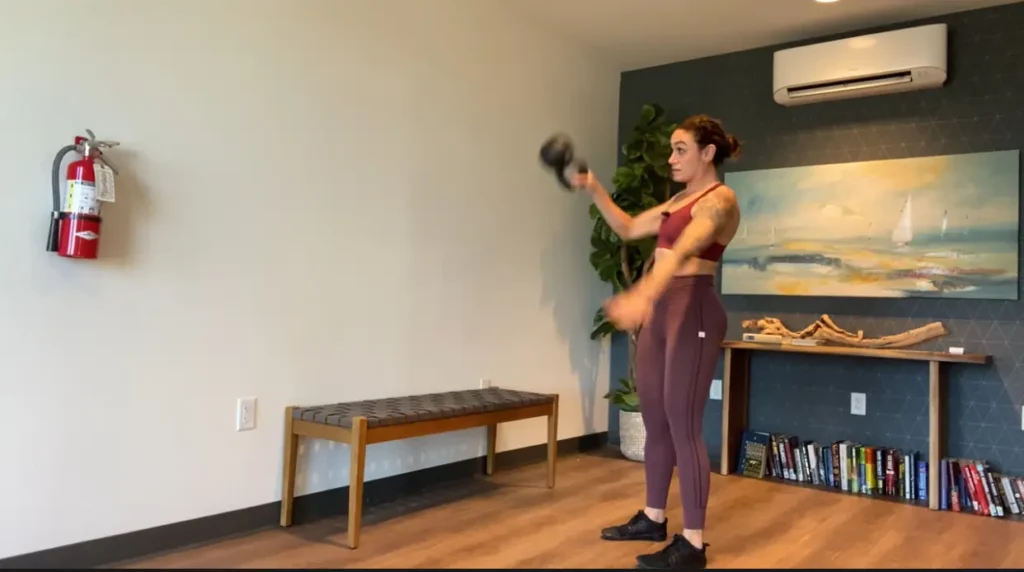

Useful Tips for Perfecting the Kettlebell Snatch
- Keep the kettlebell close to your body throughout the movement. Think “zipping up your midline.”
- Maintain a strong and stable core to protect your lower back. And make sure your hips are creating the power, not your arms or your back.
- Practice proper breathing, and exhale during the explosive part of the movement.
- Start with a lighter weight to focus on form before progressing to heavier loads.
Kettlebell Drills (The 3 Components of the Snatch)
To get a good feel for the snatch, you’ll need to practice these skills separately and then in succession with each other. They will build grip strength, cardiovascular endurance, and overall body conditioning, which are all things you need for the snatch.
Practice: The Kettlebell Deadlift
To understand where the power of the movement comes from, start with the single-arm kettlebell deadlift.
Place the bell between your feet, hinge your hips back, and keep it close to your body as you stand with it in your grip. Keep your shoulders level with each other, activating your core.
Place it right back down between your feet, tracing the movement you just did with your hips, looking to actively feel your hamstrings on your way down.
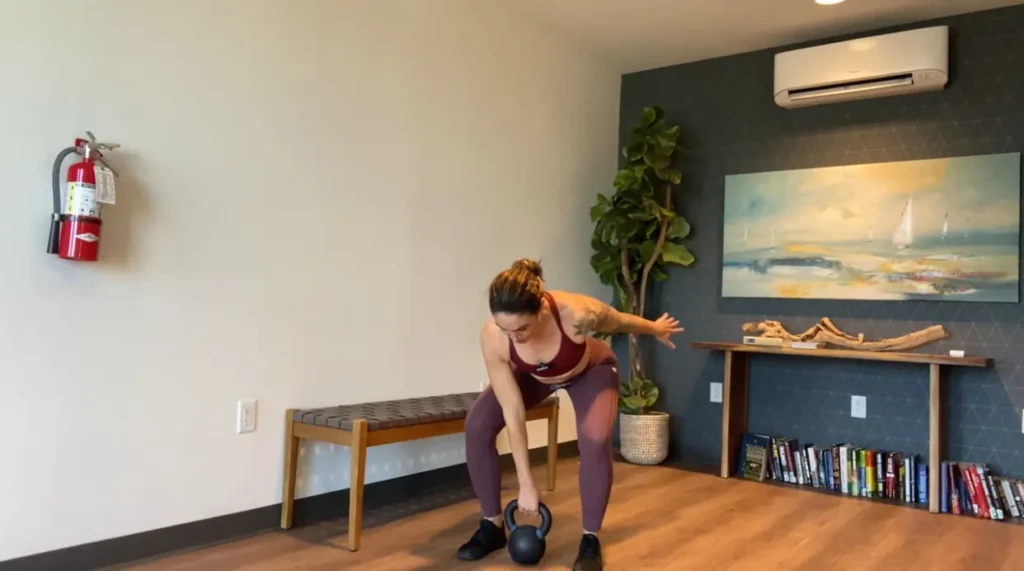
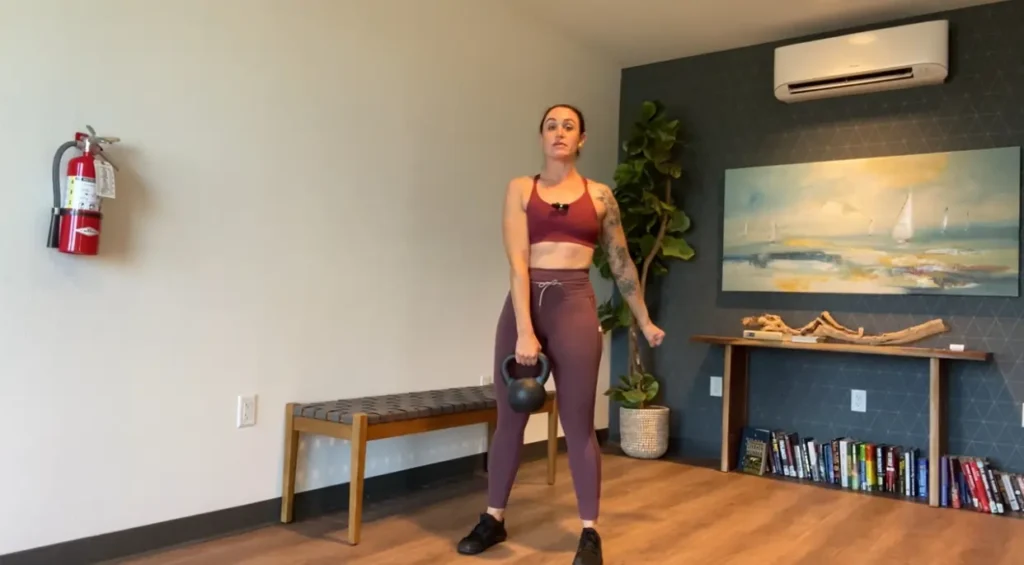
Practice: The Kettlebell Single-Arm Swing
Once you have a good feel for the deadlift, take a step back from the kettlebell and place your hand on the handle. Tilt the kettlebell towards you and hinge your hips back, then pull the bell between your legs and thrust your hips forward to push the kettlebell forward, like a pendulum swing.
Let the kettlebell come to its “weightless” point at the top of your swing and pay special attention to where it is in space. It should feel like it is light right before it changes direction to go back down towards your legs.
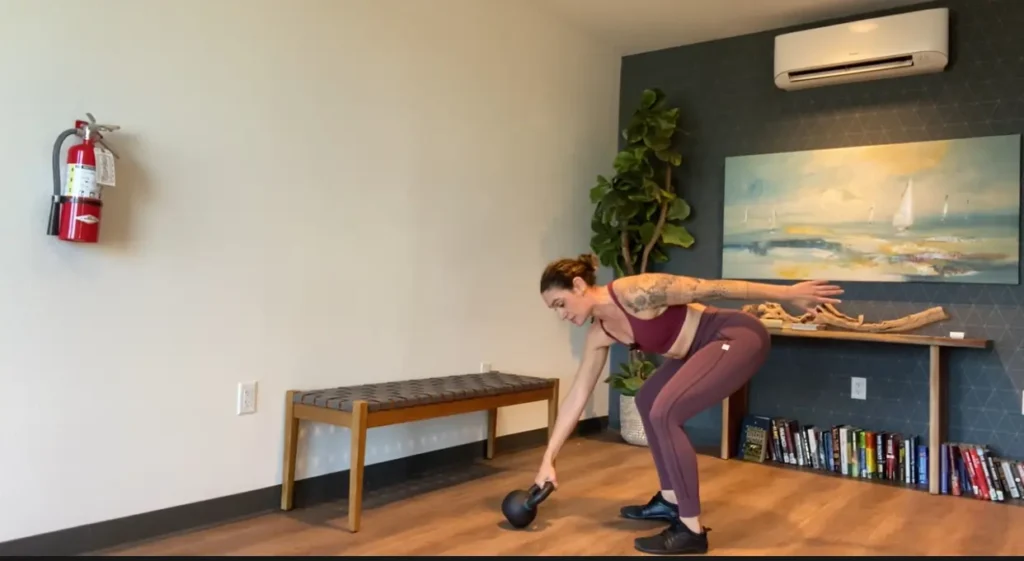
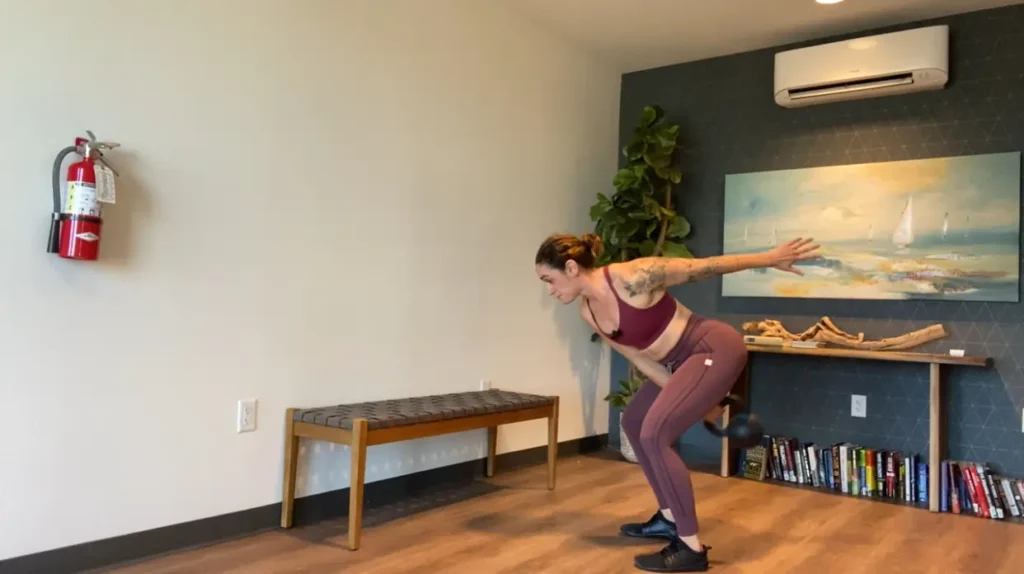

Practice: The Kettlebell High Pull
Once you have reached a level of comfort with the swing, you can try the high pull. You’ll set up the swing the same way and instead of letting your arm go all the way up, you’ll intercept the swing and pull up through your midline, with your elbow leading the way.

Practice: The Kettlebell Punch
During the high pull, you’ll again look for the “weightless” feeling and that’s when you’ll practice the punch. Get your arm as straight as possible next to your ear and wait a second or two before you dismount.
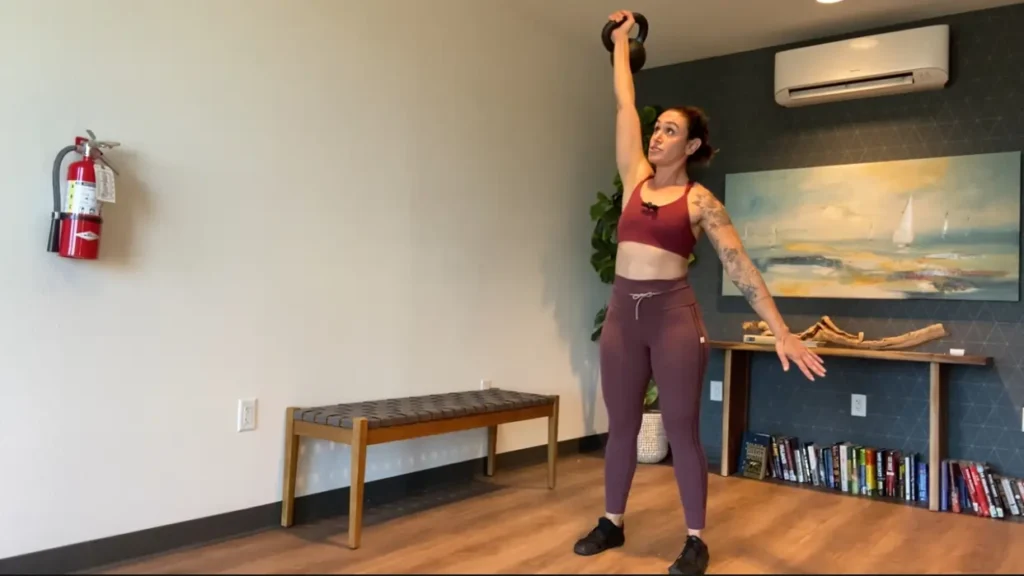
Why Do the Kettlebell Snatch?
Total Body Engagement
The snatch engages multiple muscle groups simultaneously, fostering functional strength and coordination.
Cardiovascular Endurance
Its high-intensity nature elevates heart rate, doubling as a cardiovascular workout.
It can make any strength set a high-intensity set. And heart rate elevation happens quickly—I’m talking 0 to 60 in a matter of seconds. Or, rather, 60 to 130.
Enhanced Explosiveness
The explosive hip extension and overhead lockout build power and speed. The repetitive nature of snatches also builds endurance and overall resilience. It’s also an efficient calorie burner, naturally aiding in weight loss and fat burning.
Muscle Groups Targeted by the Kettlebell Snatch
- Lower Body: Primarily engages glutes, hamstrings, and quadriceps for explosive hip extension.
- Core: Develops core strength and stability for movement control and balance.
- Shoulders & Upper Back: Involves deltoids, trapezius, and lats during the lift and overhead lockout.
- Grip: Builds forearm and grip strength
Challenges to Watch Out For
Improper Technique
Often I hear clients complain that the kettlebell “flops” down on the wrist creating bruises. This is due to improper technique and timing. If you’re getting bruises from kettlebells, something is off.
Focus on mastering the swing, high pull, and overhead lockout or “punch” before attempting the full snatch. Those three movements are a great way to build the technical part of this compound movement piece by piece. Once you have those specifics down, you can challenge yourself to put them together with one fluid motion.
Fatigue & Grip Challenges
Since the kettlebell snatch is such a powerful and technical movement, gradually increasing volume while perfecting the technique is the best way to increase resistance and difficulty.
Some great ways to practice grip-specific exercises are farmer’s walks or static holds to improve grip endurance. Once you have some practice under your belt just with the grip itself, the snatch becomes far more achievable.
Shoulder Mobility & Stability
Often our work and day-to-day inactivity leads to poor shoulder mobility so asking to lockout at the top position with a weighted kettlebell becomes almost impossible.
Work on shoulder mobility drills like plank shoulder taps and kettlebell arm bars to get some musculoskeletal fire before you start swinging. It’s super important to practice overhead shoulder and core stability exercises, like an overhead farmer’s carry, to prevent strain or injury.
Sample Workout & Progression
1. Beginner Level:
- Warm-up: 5-10 mins of mobility drills. Preferably shoulder swimmers, and hip CARs.
- Technique Focus: 3 sets x 5 reps of single-arm kettlebell swings.
- Practice: 3 sets x 5 reps of high pulls.
- Snatch Practice: 3 sets x 3 reps of kettlebell snatches per arm, focusing on form and control.
2. Intermediate Level:
- Warm-up: 5-10 mins with mobility and light single-arm swings.
- Progression: 4 sets x 5 reps of high pulls with increased weight.
- Snatch Development: 4 sets x 5 reps per arm with a moderate weight, emphasizing speed and form.
- Supplementary Exercises: Include Turkish get-ups and windmills to enhance stability and mobility.
3. Advanced Level:
- Warm-up: 10 mins mixing mobility drills and light snatches.
- Advanced Sets: 5 sets x 5 reps per arm with a challenging weight.
- Complex Training: Combine snatches with other movements like cleans or presses for added challenge and coordination.
- Cool Down: Stretching and mobility work focusing on shoulders, hips, and hamstrings.
Supporting Movements:
- Kettlebell Clean: Enhances the pulling motion and transition to the rack position, crucial for a seamless snatch.
- Kettlebell Turkish Get-Up: Boosts shoulder stability and core strength, aiding in overall snatch performance.
- Kettlebell Swing: Understand the fundamentals of a swing and where to generate the explosivity needed for the snatch.
- Windmill: Improves shoulder and hip mobility, benefiting the snatch’s lockout phase.
The Snatch: The King of Kettlebell Movements
The kettlebell snatch offers loads of benefits across multiple muscle groups. It’s a great way to get your heart rate up while using very little equipment and space, and it’s the perfect high-intensity movement to add to any workout.
While it’s not without its share of challenges, mastering the kettlebell snatch technique and incorporating supplementary movements can elevate your strength, coordination, and overall fitness.
In my opinion, the kettlebell snatch is hands-down one of the best all-around exercises there is!
Use this structured approach, focusing on technique, then gradually progress in weight load. Add supplementary exercises and keep pushing yourself to try more challenging weights and vary your workouts.
If you need more one-on-one assistance, consider booking a consultation with one of our certified personal trainers to learn how to perform this movement in a way that works for your unique body and movement style. Give it a shot today! Until next time, Gymless Heroes!

Helya is a NASM certified personal trainer with expertise in RKC, 200 Hr Yoga, Animal Flow, Precision Nutrition, Tabata, Pilates, and is currently completing her CrossFit L1 certification. She is an experienced coach with many certifications, but most of her experience comes from the hundreds of people she has helped over the last decade while owning a small functional training gym in Ventura, California. Helya is a people person passionate about helping people move well and hurt less.
